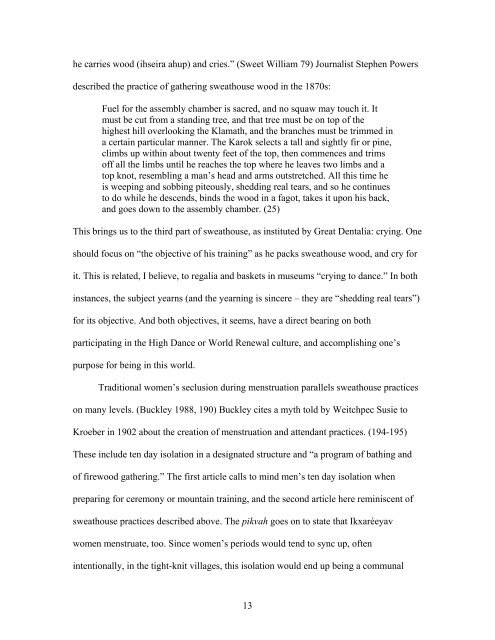The Intersection of Karuk Storytelling and Education
The Intersection of Karuk Storytelling and Education
The Intersection of Karuk Storytelling and Education
Create successful ePaper yourself
Turn your PDF publications into a flip-book with our unique Google optimized e-Paper software.
he carries wood (ihseira ahup) <strong>and</strong> cries.” (Sweet William 79) Journalist Stephen Powers<br />
described the practice <strong>of</strong> gathering sweathouse wood in the 1870s:<br />
Fuel for the assembly chamber is sacred, <strong>and</strong> no squaw may touch it. It<br />
must be cut from a st<strong>and</strong>ing tree, <strong>and</strong> that tree must be on top <strong>of</strong> the<br />
highest hill overlooking the Klamath, <strong>and</strong> the branches must be trimmed in<br />
a certain particular manner. <strong>The</strong> Karok selects a tall <strong>and</strong> sightly fir or pine,<br />
climbs up within about twenty feet <strong>of</strong> the top, then commences <strong>and</strong> trims<br />
<strong>of</strong>f all the limbs until he reaches the top where he leaves two limbs <strong>and</strong> a<br />
top knot, resembling a man’s head <strong>and</strong> arms outstretched. All this time he<br />
is weeping <strong>and</strong> sobbing piteously, shedding real tears, <strong>and</strong> so he continues<br />
to do while he descends, binds the wood in a fagot, takes it upon his back,<br />
<strong>and</strong> goes down to the assembly chamber. (25)<br />
This brings us to the third part <strong>of</strong> sweathouse, as instituted by Great Dentalia: crying. One<br />
should focus on “the objective <strong>of</strong> his training” as he packs sweathouse wood, <strong>and</strong> cry for<br />
it. This is related, I believe, to regalia <strong>and</strong> baskets in museums “crying to dance.” In both<br />
instances, the subject yearns (<strong>and</strong> the yearning is sincere – they are “shedding real tears”)<br />
for its objective. And both objectives, it seems, have a direct bearing on both<br />
participating in the High Dance or World Renewal culture, <strong>and</strong> accomplishing one’s<br />
purpose for being in this world.<br />
Traditional women’s seclusion during menstruation parallels sweathouse practices<br />
on many levels. (Buckley 1988, 190) Buckley cites a myth told by Weitchpec Susie to<br />
Kroeber in 1902 about the creation <strong>of</strong> menstruation <strong>and</strong> attendant practices. (194-195)<br />
<strong>The</strong>se include ten day isolation in a designated structure <strong>and</strong> “a program <strong>of</strong> bathing <strong>and</strong><br />
<strong>of</strong> firewood gathering.” <strong>The</strong> first article calls to mind men’s ten day isolation when<br />
preparing for ceremony or mountain training, <strong>and</strong> the second article here reminiscent <strong>of</strong><br />
sweathouse practices described above. <strong>The</strong> pikvah goes on to state that Ikxaréeyav<br />
women menstruate, too. Since women’s periods would tend to sync up, <strong>of</strong>ten<br />
intentionally, in the tight-knit villages, this isolation would end up being a communal<br />
13
















